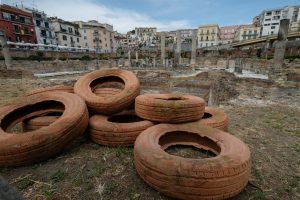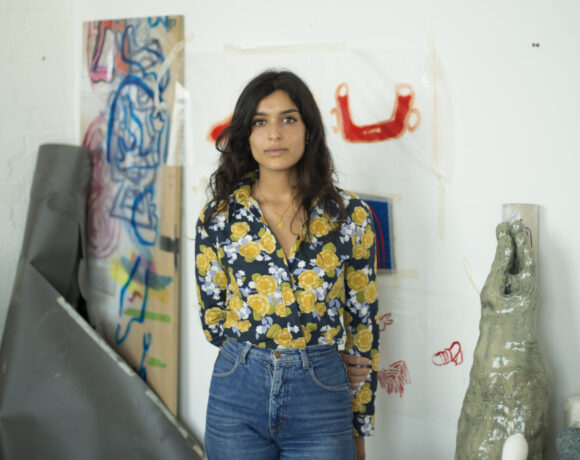The difficult interconnection, frequently underestimated, between contemporary art and archaeological finds, can often prove to be an atout. An example of this is the Kême exhibition, inaugurated on 20th June in the ancient and evocative scenery of the Macellum – Temple of Serapis in Pozzuoli. In the ancient Egyptian language, Kême indicates the “black earth”, the “raw material” which in Arabic is etymologically and syntactically transformed into al – Kimya. So, alchemy considered as a discipline aimed at transforming the raw material through fire.
If earth and fire are two of the primordial elements underlying the origin of life, at the same time they represent the origin of a geological life, but no less human: that of the Campi Flegrei, the seismic, volcanic and seething zone of Campania, rich in treasures perfectly preserved thanks to its bradyseismic nature.
Therefore, it is not surprising the choice of such an evocative title for a project to be set up on this site, which involved the contemporary sculpture of the Academy of Fine Arts in Naples and the evocative context of one of the major archaeological remains of the Parco dei Campi Flegrei, the Macellum. A market and sacred area, according to the studies carried out on the site: this duality did not go unnoticed in the eyes of the fourteen young artists of the Academy who, thinking about the suggestions raised by the proposed theme and the archaeological site, created site-specific works which are different but in dialogue with each other and with the place.
At the entrance, you will find the works of Antonio Salzano, A Ruota, and Francesca Arduino, Rubedo. The choice of framing the beginning of the path with two works conceptually distant but visually communicating with each other and in the space was probably not accidental. While the reference to contemporary archeology is direct and immediate with the twelve terracotta tyres of Salzano, Francesca Arduino’s hatched eggs contrast in a more intimate, but no less incisive, way. On the one hand, therefore, awareness of consumption and abandonment – a probable criticism also of the age-old question of illicit waste dumping -; on the other, the more direct reference to earth and alchemy, with Arduino’s phoenix eggs that raise visual suggestions on the origin of life and matter, as well as the craters that are scattered in the entire Phlegraean area. The same title chosen by the artist, Rubedo, is the Latin term that indicated the last alchemical phase of transformation of matter: the sculptures, in fact, are destined to change in contact with the atmospheric phenomena of the place.
It could be argued that the path follows the thread of the aesthetic and thematic contrast of the works. For example, the dialogue between Antonio Flumeri‘s Colonna vuota and Tammaro Menale‘s Revival leaves a similar taste of immediacy and intimacy in the mouth. With Menale – whose artistic research already moves autonomously on the concept of contemporary archeology – we seem to see again the tyres of Salzano: 12 boxes of fruit piled up in disorder, which in addition to the imagery of an archeological find appear to be abandoned in that precise moment, at the end of a trading day. Less critical, perhaps, but more anthropological, as linked to the real use of the Macellum in ancient times. Opposite, an empty colonnade stretches out on the barren ground, a classical find that aesthetically blends with the surrounding area but releases, here, a feeling of heaviness, linked to the lack and rest of manual making according to Flumeri’s vision.
There are numerous works that overlook the open space where the temple once stood, and of which the imposing columns remain. Among these, the anthropomorphic figures of Lucia Schettino, which seem to struggle with themselves and with the terracotta and iron that compose them. The tension that these living sculptures emanate, however, is a tension that, even in the act of moving away from the observer’s gaze, turns to the encounter with the historical and transformative density of the Macellum. Reliquie di Serapide by Gaetano Fabozzi follows, in the small viewpoints next door, which visually reproduces Schettino’s Visione di invasione with a mass of clay bovine bones; idea of leftover, the “remainder” as a memory and as a reference to the ossuary reliquaries found throughout the Campania region; Homo Chronos by Roberto Pesacane, a sundial held by a human hand, which cuts the background of the temple and invites us to dwell on the differences in the passage of time between matter and human being; Sea Sky Shadow, by Biagio Salvati, which shows a reflection on the element of water and its contact with the temple. The phenomenon of bradyseism, in fact, meant that the archaeological site maintained this state between the conservative and the destructive: a great drop, therefore, that threatens and protects.
Always overlooking the temple, positioned on their small viewpoints, we find the works of Salvatore Russo, Noemi Saltalamacchia and Rosanna Pezzella. The first, representing a Dioniso con satiro and visually rendered as an archaeological find, marries in a more than adequate way to the whole surrounding context – as in the sculpture of his colleague Salvatore Mancino, Ankh, where the Egyptian symbolism is taken up -, in which the wounds are caused by the union of the forces of earth, water and fire. In Saltalamacchia’s Lapis, on the other hand, we find that direct connection to the market function of the place, as in the colleague Tammaro Menale: it is in fact a composition of supports on which amorphous elements in clay stand, which impress, as they are capable of resembling leftovers of food or items intended for processing. An inevitable connection with the Macellum, the meat market, with its value of exchange and metamorphosis already captured by Schettino’s works, but also a place where you can eat. The idea, at least visually, of the flesh is then taken up again in the nearby sculpture Lapis, Serapeum, in which the artist Rosanna Pezzella deconstructs the columns of the temple of Serapis, creating new, contemporary ones, made up of layers of clay, to emphasise the bradyseism and a different vision of monumental grandeur.
But undoubtedly the most intimate aspect of the site-specific work was revealed by the works that intersect along the way, naturally hidden in some of the turning corners. Like Omphalos by Alessandro Piromallo, a delicate composition that reflects on the concept of natural balance that was established between the forces present in the Macellum, between trade and human contact; or, in the colours of Pedi by Rebecca Miccio.
The exhibition, which will be open until 30th September 2021, saw the collaboration of various local bodies – the Archaeological Park of the Phlegraean Fields, the Macellum – Temple of Serapis, the teachers of the School of Sculpture of the Academy of Fine Arts in Naples and the Aporema non-profit association, through whose collaboration it was possible to issue a thematic competition for young artists. The proposed exhibition is not only the first of a series of cultural events oriented towards the union between antiquity and contemporary use of the site, but it is also and above all a response to the incessant need for multidisciplinarity that art and society, today more than ever, require in community life. A project that invites you to shift the focus to emerging art, but which has also led to the production of new themes, observations and works that, in their act of going “unnoticed”, are fully realized with respect and delicacy.
Sara Maietta
Info:
Mostra di scultura/ Kême
20 June – 30 September 2021
Macellum – Tempio di Serapide
Via Serapide 13, 80078 Pozzuoli (NA)
 Antonio Salzano, A ruota, variable sizes, terracotta, chemicals, 2021. Moments of the inauguration of the exhibition KEME at Macellum-Temple of Serapis in Pozzuoli. Ph. Mario Laporta/KONTROLAB
Antonio Salzano, A ruota, variable sizes, terracotta, chemicals, 2021. Moments of the inauguration of the exhibition KEME at Macellum-Temple of Serapis in Pozzuoli. Ph. Mario Laporta/KONTROLAB
 Francesca Arduino, Rubedo, variable sizes, raw clay, terracotta, lapillus and pumice of volcanic origin, 2021. Moments of the inauguration of the exhibition KEME at Macellum-Temple of Serapis in Pozzuoli. Ph. Mario Laporta/KONTROLAB
Francesca Arduino, Rubedo, variable sizes, raw clay, terracotta, lapillus and pumice of volcanic origin, 2021. Moments of the inauguration of the exhibition KEME at Macellum-Temple of Serapis in Pozzuoli. Ph. Mario Laporta/KONTROLAB
 Antonio Flumeri, Colonna vuota, cm 288 x 58 x 58, terracotta, iron, wood, 2017. Moments of the inauguration of the exhibition KEME at Macellum-Temple of Serapis in Pozzuoli. Ph. Mario Laporta/KONTROLAB
Antonio Flumeri, Colonna vuota, cm 288 x 58 x 58, terracotta, iron, wood, 2017. Moments of the inauguration of the exhibition KEME at Macellum-Temple of Serapis in Pozzuoli. Ph. Mario Laporta/KONTROLAB
 Tammaro Menale, Revival, variable measures, terracotta, 2021. Moments of the inauguration of the exhibition KEME at Macellum-Temple of Serapis in Pozzuoli. Ph. Mario Laporta/KONTROLAB
Tammaro Menale, Revival, variable measures, terracotta, 2021. Moments of the inauguration of the exhibition KEME at Macellum-Temple of Serapis in Pozzuoli. Ph. Mario Laporta/KONTROLAB
 Noemi Saltalamacchia, Lapis, cm 150 x 150, clay, pigments, pumice, wood, 2021. Moments of the inauguration of the exhibition KEME at Macellum-Temple of Serapis in Pozzuoli. Ph. Mario Laporta/KONTROLAB
Noemi Saltalamacchia, Lapis, cm 150 x 150, clay, pigments, pumice, wood, 2021. Moments of the inauguration of the exhibition KEME at Macellum-Temple of Serapis in Pozzuoli. Ph. Mario Laporta/KONTROLAB
 Rebecca Miccio, Pedi, cm 140 x 25 x 75, white and acrylic earthenware, 2021. Moments of the inauguration of the exhibition KEME at Macellum-Temple of Serapis in Pozzuoli ph. Mario Laporta/KONTROLAB
Rebecca Miccio, Pedi, cm 140 x 25 x 75, white and acrylic earthenware, 2021. Moments of the inauguration of the exhibition KEME at Macellum-Temple of Serapis in Pozzuoli ph. Mario Laporta/KONTROLAB
For all the images: courtesy prof. Antonio Manzoni – Aporema Onlus

Naples, 1996. She deals with artistic curatorship, with particular attention to emerging artists dealing with political and social criticism. She first graduated in Territoire et Patrimoine at the Université Paris Nanterre, she specialized in Cultural Heritage Management at the Federico II University in Naples with an analytical thesis on the rise and decline of the contemporary art curator. In 2021 she takes part in the N.I.C.E. by Paratissima. She firmly believes in the social value of art, she has collaborated with several Neapolitan galleries and participated in an artistic residency at the Morra Foundation. Meanwhile, she writes for art magazines.






NO COMMENT